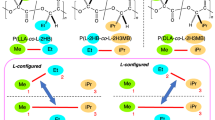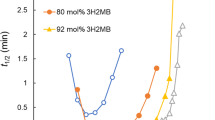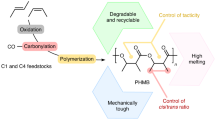Abstract
The maximum radial growth rate of spherulites of the novel stereocomplexationable blend of poly(L-2-hydroxybutyrate) (P(L-2HB)) and poly(D-2-hydroxybutyrate) (P(D-2HB)) was observed to be substantially higher than those of pure P(L-2HB) and P(D-2HB). The hydrolytic degradation rate of the P(L-2HB)/P(D-2HB) blend traced by gravimetry and gel permeation chromatography was significantly lower than those of pure P(L-2HB) and P(D-2HB); this indicated that the blend had higher resistance to hydrolytic degradation. Further, the thermal degradation rate of the P(L-2HB)/P(D-2HB) blend was retarded as compared with those of pure P(L-2HB) and P(D-2HB). The results obtained in the present study indicate that the intermolecular interaction between P(L-2HB) and P(D-2HB) chains having opposite configurations in the amorphous regions or in the molten state was higher than that between P(L-2HB) or P(D-2HB) chains with the same configurations. The information obtained in the present study should be very useful for designing and processing pure, biodegradable materials of P(L-2HB), P(D-2HB) and their blends for biomedical, pharmaceutical and environmental applications.
Similar content being viewed by others
Log in or create a free account to read this content
Gain free access to this article, as well as selected content from this journal and more on nature.com
or
References
Kharas, G. B., Sanchez-Riera, F. & Severson, D. K. in Plastics from Microbes (ed. Mobley, D. P.), 93–137 (Hanser Publishers, New York, 1994).
Doi, Y. & Fukuda, K. (eds) Biodegradable Plastics and Polymers (Elsevier, Amsterdam, 1994).
Li, S. & Vert, M. in Degradable Polymers. Principles and Applications (eds Scott, G. & Gilead, D.) 43–87, (Chapman & Hall, London, 1995).
Hartmann, M. H. in Biopolymers from Renewable Resources (ed. Kaplan, D. L.) 367–411 (Springer, Berlin, 1998).
Ikada, Y. & Tsuji, H. Biodegradable polyesters for medical and ecological applications. Macromol. Rapid Commun. 21, 117–132 (2000).
Garlotta, D. A literature review of poly(lactic acid). J. Polym. Environ. 9, 63–84 (2001).
Albertsson, A.- C. (ed.). Degradable Aliphatic Polyesters (Advances in Polymer Science Vol. 157: (Springer, Berlin, 2002).
Södergård, A. & Stolt, M. Properties of lactic acid based polymers and their correlation with composition. Prog. Polym. Sci. 27, 1123–1163 (2002).
Scott, G. (ed.) Biodegradable Polymers. Principles and Applications. 2nd edn (Kluwer Academic Publishers, Dordrecht, The Netherlands, 2002).
Tsuji, H. in Polyesters 3 (Biopolymers Vol. 4: (eds Doi, Y. & Steinbüchel, A.) 129–177 (Weinheim (Germany), Wiley-VCH, 2002).
Auras, R., Harte, B. & Selke, S. An overview of polylactides as packaging materials. Macromol. Biosci. 4, 835–864 (2004).
Gupta, A. P. & Kumar, V. New emerging trends in synthetic biodegradable polymers Polylactide: a critique. Eur. Polym. J. 43, 4053–4074 (2007).
Slager, J. & Domb, A. J. Biopolymer stereocomplexes. Adv. Drug Delivery Rev. 55, 549–583 (2003).
Tsuji, H. Poly(lactide) stereocomplexes: formation, structure, properties, degradation, and applications. Macromol. Biosci. 5, 569–597 (2005).
Fukushima, K. & Kimura, Y. Stereocomplexed polylactides (Neo-PLA) as high-performance bio-based polymers: their formation, properties, and application. Polym. Int. 55, 626–642 (2006).
Tsuji, H. In vitro hydrolysis of blends from enantiomeric poly(lactide)s. 1. Well-stereocomplexed blend and non-blended films. Polymer 41, 3621–3630 (2000).
de Jong, S. J., van Eerdenbrugh, B., van Nostrum, C. F., Kettenes-van den Bosch, J. J. & Hennink, W. E. Physically crosslinked dextran hydrogels by stereocomplex formation of lactic acid oligomers: degradation and protein release behavior. J. Control. Rel. 71, 261–275 (2001).
Andersson, S. R., Hakkarainen, M., Inkinen, S., Södergård, A. & Albertsson, A.- C. Polylactide stereocomplexation leads to higher hydrolytic stability but more acidic hydrolysis product pattern. Biomacromolecules 11, 1067–1073 (2010).
Tsuji, H. & Tsuruno, T. Accelerated hydrolytic degradation of poly(L-lactide)/poly(D-lactide) stereocomplex up to late stage. Polym. Degrad. Stab. 95, 477–484 (2010).
Tsuji, H. & Fukui, I. Enhanced thermal stability of poly(lactide)s in the melt by enantiomeric polymer blending. Polymer 44, 2891–2896 (2003).
Tsuji, H. & Okumura, A. Stereocomplex formation between enantiomeric substituted poly(lactide)s: blends of poly[(S)-2-hydroxybutyrate] and poly[(R)-2-hydroxybutyrate]. Macromolecules 42, 7263–7266 (2009).
Tsuji, H., Yamamoto, S., Okumura, A. & Sugiura, Y. Heterostereocomplexation between biodegradable and optically active polyesters as a versatile preparation method for biodegradable materials. Biomacromolecules 11, 252–258 (2010).
Tsuji, H. & Matsuoka, H. Stereoselective interaction between isotactic and optically active poly(lactic acid) and phenyl-substituted poly(lactic acid). Macromol. Rapid Commun. 29, 1372–1377 (2008).
Tsuji, H., Matsuoka, H. & Itsuno, S. Synthesis, physical properties, and crystallization of optically active poly(L-phenyllactic acid) and poly(L-phenyllactic acid-co-L-lactic acid). J. Appl. Polym. Sci. 110, 3954–3962 (2008).
Tsuji, H. & Tezuka, Y. Stereocomplex formation between enantiomeric poly(lactic acid)s. XII. Spherulite growth of low-molecular-weight poly(lactic acid)s. Biomacromolecules 5, 1181–1186 (2004).
Tsuji, H. & Ikada, Y. Stereocomplex formation between enantiomeric poly(lactic acid)s. 9. Stereocomplexation from the melt. Macromolecules 26, 6918–6926 (1993).
Marega, C., Marigo, A., Di Noto, V., Zannetti, R., Martorana, A. & Paganetto, G. Structure and crystallization kinetics of poly(L-lactic acid). Makromol. Chem. 193, 1599–1606 (1992).
Tsuji, H. & Ikada, Y. Properties and morphologies of poly(L-lactide): 1. Annealing effects on properties and morphologies of poly(L-lactide). Polymer 36, 2709–2716 (1995).
Yamane, H . & Sasai, K . Effect of the addition of poly(d-lactic acid) on the thermal property of poly(l-lactic acid). Polymer 44, 2569–2575 (2003).
Bouapao, L. & Tsuji, H. Stereocomplex crystallization and spherulite growth of low-molecular-weight poly(L-lactide) and poly(D-lactide) from the melt. Macromol. Chem. Phys. 210, 993–1002 (2009).
Tsuji, H. Degradation of Poly(lactide)-Based Biodegradable Materials (Nova Science Publishers, New York, 2007).
Tsuji, H. in Biodegradable Polymers for Skeletal Implants (eds Wuisman, P. I. J. M. & Smit, T. H.) 41–71 (Nova Science Publishers, New York, 2009).
Tsuji, H. in Poly(lactic acid): Synthesis, Structures, Properties, Processing, and Applications (eds Auras, R., Lim, L. -T., Selke, S. & Tsuji, H.) 345–381 (John Wiley and Sons, NJ, 2010).
Karst, D. & Yang, Y. Effect of arrangement of L-lactide and D-lactide in poly[(L-lactide)-co-(D-lactide)] on its resistance to hydrolysis studied by molecular modeling. Macromol. Chem. Phys. 209, 168–174 (2008).
Ozawa, T. A new method of analyzing thermogravimotric data. Bull. Chem. Soc. Jpn 38, 1881–1886 (1965).
Acknowledgements
We thank Mr Yuzuru Sakamoto of the Department of Environmental and Life Sciences, Graduate School of Engineering at Toyohashi University of Technology for his GPC data analysis. This research was supported by a Grand-in-aid for Scientific Research, Category ‘C’, No. 19500404, from the Japan Society for the Promotion of Science (JSPS).
Author information
Authors and Affiliations
Corresponding author
Rights and permissions
About this article
Cite this article
Tsuji, H., Okumura, A. Crystallization and hydrolytic/thermal degradation of a novel stereocomplexationable blend of poly(L-2-hydroxybutyrate) and poly(D-2-hydroxybutyrate). Polym J 43, 317–324 (2011). https://doi.org/10.1038/pj.2010.133
Received:
Revised:
Accepted:
Published:
Issue date:
DOI: https://doi.org/10.1038/pj.2010.133
Keywords
This article is cited by
-
Engineering d-Lactate Dehydrogenase from Pediococcus acidilactici for Improved Activity on 2-Hydroxy Acids with Bulky C3 Functional Group
Applied Biochemistry and Biotechnology (2019)
-
Miscibility, Thermal and Mechanical Properties of Poly(para-dioxanone)/Poly(lactic-co-glycolic acid) Blends
Journal of Polymers and the Environment (2015)



